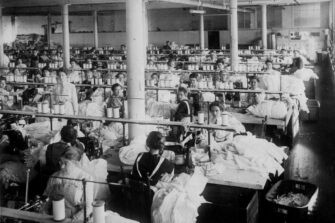Clara Lemlich and Mother Jones, two prominent figures in American labor history, dedicated their lives to fighting for workers’ rights. While both women were passionate advocates for improved working conditions, their approaches and the specific issues they championed differed in significant ways. This article explores the distinct contributions of Lemlich and Jones to the labor movement and compares their legacies.
Clara Lemlich: Igniting the Uprising of the 20,000
Clara Lemlich, a young Ukrainian immigrant working in New York City’s garment industry, is best remembered for her pivotal role in the 1909 “Uprising of the 20,000.” Frustrated by exploitative conditions, including long hours, low wages, and unsafe factories, Lemlich galvanized her fellow workers, primarily young Jewish and Italian women, to take action. At a massive labor meeting, she famously interrupted a series of speeches, urging immediate strike action. Her impassioned call resonated with the crowd, leading to a walkout that paralyzed the garment industry for weeks.
Lemlich’s fiery oratory and organizing skills were instrumental in achieving significant improvements for garment workers. The strike led to shorter workweeks, higher wages, and improved safety standards in many factories. Her activism focused on organizing women workers and highlighting the specific challenges they faced in the workplace. She challenged the prevailing gender norms of the time by empowering women to fight for their own economic and social justice.
Mother Jones: Championing the Cause of Miners and Children
Mother Jones, born Mary Harris Jones, was a fiery labor organizer known for her unwavering commitment to miners’ rights and her passionate advocacy against child labor. She traveled extensively throughout the United States, organizing coal miners and leading strikes in some of the most dangerous and contentious labor battles of the early 20th century.
Jones’s activism extended beyond miners. She famously led the “March of the Mill Children” in 1903, bringing attention to the plight of children working in textile mills. The march, which involved children walking from Philadelphia to President Theodore Roosevelt’s summer home, aimed to expose the brutal conditions faced by child laborers and advocate for legislative reforms.
Comparing Their Legacies: Different Approaches, Shared Goals
While Lemlich focused primarily on organizing women in the garment industry, Jones’s work encompassed a broader range of industries and issues. Lemlich’s activism often involved direct action, such as strikes and protests, while Jones utilized a variety of tactics, including public speaking, marches, and organizing communities.
Despite their different approaches, both Lemlich and Jones were driven by a deep commitment to social justice and a belief in the power of collective action. Both women faced immense opposition from powerful corporations and government authorities but remained steadfast in their dedication to improving the lives of working people. Their tireless efforts helped to lay the foundation for many of the labor rights and protections that workers enjoy today.
Conclusion: Two Powerful Voices for Change
Clara Lemlich and Mother Jones represent two powerful voices in the American labor movement. While they focused on different industries and utilized distinct strategies, their shared commitment to workers’ rights and social justice left an enduring legacy. Their contributions continue to inspire activists and labor organizers fighting for fair working conditions and economic equality today. Both women’s stories highlight the crucial role that individuals can play in challenging injustice and advocating for positive social change.
